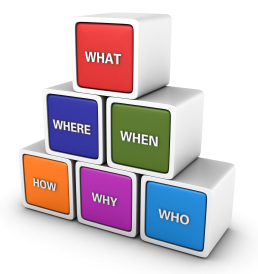The Five W’s (and one H) of Designing Cost Systems
There comes a point in every process manufacturing organization when you know that you need a robust cost accounting system. Whether you choose to build a system from scratch, or purchase and configure a system, there are six questions you should ask (and answer) before you embark on the project.
 WHO benefits from the cost system?
WHO benefits from the cost system?
There are two distinct audiences for a cost system. The most obvious are the cost accountants and managers who use the system daily. This group is most interested in increasing accuracy and functionality, reducing the time needed to maintain the system, and eliminating redundancy when entering data. Beyond the daily users, there is a group of stakeholders who have less interest in the inner workings of the system, but they are customers of the data that is generated in the cost system. These plant managers, sales and marketing managers, industrial engineers, and IT managers all have a vested interest in ensuring that the cost system delivers accurate results and works well with the existing IT architecture. The cost system must meet the needs of both groups to gain acceptance in your company.
WHAT should be included in the design of the cost system?
The biggest driver of the cost system’s design is determined by the information needs of the organization. Do you need to know standard costs, actual costs, or both? Are you a job costing or activity-based costing shop? Do you understand the effects of changing market conditions on your production costs? The answers to these questions lead to more questions that ultimately lead to the best methods to integrate systems and report results.
WHEN will the model interactions occur?
The most significant interaction between your cost system and the other systems occurs at launch. It’s when all of the bells and whistles are turned on, costs are calculated, reports are generated and systems are updated. To get to the launch date, you need a detailed project plan that includes target dates, milestones, delivery schedules and critical paths are keys to success. Support from your company’s leadership team is probably the most important factor in making sure that the project gets off the ground and moves to completion. Once it’s up and running, every other interaction is of equal importance. Establishing the frequency of the cycle (daily, weekly, monthly, annually) to input and extract data is critical to providing relevant information to all of the cost system’s stakeholders.
WHERE should you locate the cost system?
The physical location of the cost system will impact the overall design of the models and how they function. Some companies require a centrally managed solution where the corporate cost accounting group manages all costing and each manufacturing facility uses the same rules for calculating costs. Another option is a co-located system where system resides on a dedicated server and is generally managed by a costing group, but each manufacturing facility has their own costing rules. The third option is the ‘build and drop’ system where each manufacturing facility has its own cost system installed on a local server. Here, the costing rules are specific to the location and maintained by the local staff. The best approach varies and it’s up to your leadership team to decide the best approach to roll out your costing system.
WHY do you need a cost system?
There are so many reasons why a company would want a cost system, but there’s only one reason why you need one – to know your costs. Without accurately knowing the costs associated with producing the goods you sell, you’ll never know if you’re maximizing profits, selling to the right customers, producing the best mix of products, or any of other important metrics for success in your business. At the root of every major business decision is the cost of producing the products you sell.
And finally, HOW do you get a cost system that delivers what you need?
The first step to getting the cost system of your dreams is by avoiding the pitfalls that lie on the path to success. Approaches like hard-coding calculations and comparisons make maintaining logic and data a chore. For it to be less stressful, you can be more knowledgeable of every aspect thanks to educational platforms. Focus on making your costing system as flexible as possible to ease configuring and troubleshooting your models. Next, take a hard look at the available data and match the inputs to your desired results to make sure your goals are achievable. Third, create a development plan that is attainable by staging components of your cost system (product costs, inventory valuation, materials management, forecasting), so the project doesn’t become overcomplicated and ultimately is never launched. To take a quick rest from all these, you can play games such as BETEND.